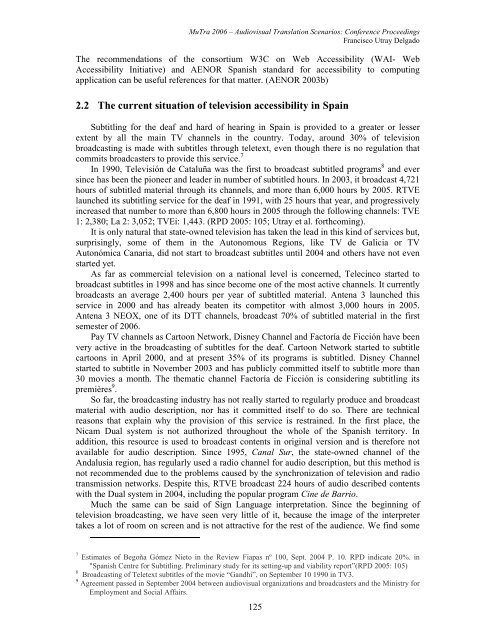Proceedings - Translation Concepts
Proceedings - Translation Concepts
Proceedings - Translation Concepts
You also want an ePaper? Increase the reach of your titles
YUMPU automatically turns print PDFs into web optimized ePapers that Google loves.
MuTra 2006 – Audiovisual <strong>Translation</strong> Scenarios: Conference <strong>Proceedings</strong><br />
Francisco Utray Delgado<br />
The recommendations of the consortium W3C on Web Accessibility (WAI- Web<br />
Accessibility Initiative) and AENOR Spanish standard for accessibility to computing<br />
application can be useful references for that matter. (AENOR 2003b)<br />
2.2 The current situation of television accessibility in Spain<br />
Subtitling for the deaf and hard of hearing in Spain is provided to a greater or lesser<br />
extent by all the main TV channels in the country. Today, around 30% of television<br />
broadcasting is made with subtitles through teletext, even though there is no regulation that<br />
commits broadcasters to provide this service. 7<br />
In 1990, Televisión de Cataluña was the first to broadcast subtitled programs 8 and ever<br />
since has been the pioneer and leader in number of subtitled hours. In 2003, it broadcast 4,721<br />
hours of subtitled material through its channels, and more than 6,000 hours by 2005. RTVE<br />
launched its subtitling service for the deaf in 1991, with 25 hours that year, and progressively<br />
increased that number to more than 6,800 hours in 2005 through the following channels: TVE<br />
1: 2,380; La 2: 3,052; TVEi: 1,443. (RPD 2005: 105; Utray et al. forthcoming).<br />
It is only natural that state-owned television has taken the lead in this kind of services but,<br />
surprisingly, some of them in the Autonomous Regions, like TV de Galicia or TV<br />
Autonómica Canaria, did not start to broadcast subtitles until 2004 and others have not even<br />
started yet.<br />
As far as commercial television on a national level is concerned, Telecinco started to<br />
broadcast subtitles in 1998 and has since become one of the most active channels. It currently<br />
broadcasts an average 2,400 hours per year of subtitled material. Antena 3 launched this<br />
service in 2000 and has already beaten its competitor with almost 3,000 hours in 2005.<br />
Antena 3 NEOX, one of its DTT channels, broadcast 70% of subtitled material in the first<br />
semester of 2006.<br />
Pay TV channels as Cartoon Network, Disney Channel and Factoría de Ficción have been<br />
very active in the broadcasting of subtitles for the deaf. Cartoon Network started to subtitle<br />
cartoons in April 2000, and at present 35% of its programs is subtitled. Disney Channel<br />
started to subtitle in November 2003 and has publicly committed itself to subtitle more than<br />
30 movies a month. The thematic channel Factoría de Ficción is considering subtitling its<br />
premières 9 .<br />
So far, the broadcasting industry has not really started to regularly produce and broadcast<br />
material with audio description, nor has it committed itself to do so. There are technical<br />
reasons that explain why the provision of this service is restrained. In the first place, the<br />
Nicam Dual system is not authorized throughout the whole of the Spanish territory. In<br />
addition, this resource is used to broadcast contents in original version and is therefore not<br />
available for audio description. Since 1995, Canal Sur, the state-owned channel of the<br />
Andalusia region, has regularly used a radio channel for audio description, but this method is<br />
not recommended due to the problems caused by the synchronization of television and radio<br />
transmission networks. Despite this, RTVE broadcast 224 hours of audio described contents<br />
with the Dual system in 2004, including the popular program Cine de Barrio.<br />
Much the same can be said of Sign Language interpretation. Since the beginning of<br />
television broadcasting, we have seen very little of it, because the image of the interpreter<br />
takes a lot of room on screen and is not attractive for the rest of the audience. We find some<br />
7 Estimates of Begoña Gómez Nieto in the Review Fiapas nº 100, Sept. 2004 P. 10. RPD indicate 20%. in<br />
"Spanish Centre for Subtitling. Preliminary study for its setting-up and viability report”(RPD 2005: 105)<br />
8 Broadcasting of Teletext subtitles of the movie “Gandhi”, on September 10 1990 in TV3.<br />
9 Agreement passed in September 2004 between audiovisual organizations and broadcasters and the Ministry for<br />
Employment and Social Affairs.<br />
125
















